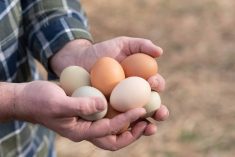Well that wasn’t much fun.
If you finished your 2019 harvest in good time with little broken equipment and a low level of frustration, congratulations! But you probably shouldn’t tell anyone.
This was not a great harvest on our farm. After a dry summer in southeast Saskatchewan, suddenly it would not stop raining. We (thankfully) got the lentils and most of the canola harvested in semi-reasonable time, but it was the end of October before it was finally dry enough to pick up the durum. The ground under the peas never did dry up — what’s left of them is still out there, waiting to be dealt with before we can seed next spring.
Read Also

Health hazards are often overlooked risks on the farm
While quite different from the dangers posed by farm machinery, hazards such as loud noise or sun exposure require the same proactive attention, the Canadian Agricultural Safety Association says.
Despite all of our challenges, we managed to get through harvest with only one threat of “I’m calling the Richie Brothers.” (Related note: Remember to tell new grain cart operators not to try to back up. Especially on a dark evening when one of the augers in the yard is already broken and the durum isn’t as dry as a person would like.)
And now it’s over and we’re putting the whole rodeo behind us. We’re moving on to worry about next year, when we’ll be planting another crop.
Seed breeding funding
With harvest over, it’s time to get back to that discussion we started in the spring. Seed breeders are looking for more funding, and industry groups are working with Agriculture and Agri-Food Canada to see how we might like to pay for it.
In consultations last winter, the seed industry suggested a couple of models: trailing royalties, where we would continue to pay royalties for new varieties for multiple years after we buy the seed, and end point royalties, where we would pay an extra fee at the elevator for the use of a particular seed.
So what do farmers think? The Alberta Federation of Agriculture (AFA), the Agricultural Producers Association of Saskatchewan (APAS), and the Keystone Agricultural Producers of Manitoba (KAP) took an online survey to find out. They got 1,136 responses from farmers.
The majority of these farmers didn’t care too much for either of these two options. Only 14 per cent agreed that end point royalties were worth further consultation, and 12 per cent agreed that trailing royalties were worth further consultation.
“Of course,” you’re thinking. “If you ask me how I’d like to pay more, I’ll probably reply that I just don’t want to pay more.”
But that didn’t really seem to be the case. Overall, more than two-thirds (68 per cent) of respondents said that “increased investment in crop development is required provided it ensures long-term stable funding for public and university breeding programs.”
In our December issue of Grainews we have a list of new seed varieties coming out for 2020. Where companies are selling hybrids and can benefit financially every year, there is definitely more development. Compare the long lists of new corn and canola options to the much shorter list of new wheat, durum and barley options. Perhaps we don’t need 27 new seed options for every commodity every year, but there is probably room for more genetic research into the crops we grow as staples.
How should we pay?
Just over two-thirds (64 per cent) of the farmers replying to the survey from AFA, APAS and KAP agreed that “increased investment in crop development is required, provided producers have oversight into how much is collected and what the funds are used for.”
This makes sense to me. We’re already electing farmers to commodity boards across the Prairies, and these boards are already investing our money into research and development. These elected reps are studying the issues and taking time to learn about research needs and processes. Through our votes, they’re accountable to us. They’re farmers themselves, and they understand what we need. Why not have these board members allocate breeding money while they’re at it?
With the seed industry making a case for new investment and two-thirds of farmers surveyed saying they wouldn’t mind paying for it, something is likely to happen on this front.
The simplest and most hassle-free way to get more money to our commodity organizations to allocate for seed breeding is likely through some kind of end point royalty system. Grain companies already collect levies from us when we deliver grain, and they already turn the money over to commodity organizations. There’s no reason this has to be more complicated than just increasing our levies. We could get fancy, and charge different rates for different grain varieties. This would mean asking elevator companies to keep some samples and perform some random audits, to make sure nobody is pretending to deliver the “cheapest” varieties when they should be paying more. But we’re already signing forms to declare our varieties at the point of sale, so this shouldn’t be a major logistical challenge.
With the winter ahead to debate and discuss how this can happen and how much we’re willing to pay for more genetic research, let’s not make it more complicated than it needs to be.















